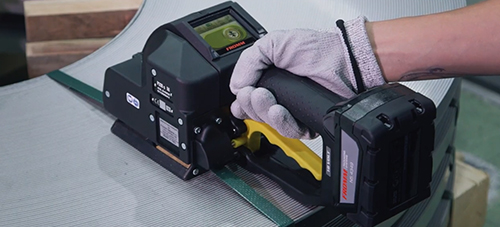If you’re in the market for new strapping tools, you might feel overwhelmed by the selection. There are many different manufacturers, and each of them has several different models. How do you know what to choose?
There are a few different things to consider when selecting a strapping tool to best fit your needs. These top five tips can help you make the right choice.
1. Look for Safety Features
The first thing to consider when selecting any strapping tool is the safety of your team. You want to choose a tool that has great safety features, so your employees can stay safe on the job.
Newer tools, like the FROMM S-series models, often come with more advanced safety features built right into the design of the tool. They may have guards on moving parts, or come with automatic lock features that prevent the tool from operating at certain times or in certain positions.
A safer tool means fewer injuries and less time lost to pinched fingers and cuts. It can also help your team get their job done more efficiently.
2. Versatility Is Key
Versatility is another important consideration when buying new strapping tools. You can buy a tool that handles only one type of strap, but chances are, your team uses multiple types of straps for different kinds of loads. It’s likely that they’ll need a tool that can handle pallets, corrugated boxes, and more.
You’ll also want to think about different settings. How easy is it to switch between manual, semi-automatic, and automatic settings? Some tools only have one setting, which makes them inappropriate for some jobs.
Instead of buying several different tools that only handle one job, look for tools that will tackle all of your strapping jobs.
3. Think about Value
When it comes to picking a new strapping tool, it can be tempting to focus on cost. Many people look for the lowest price and pick their tool based on that number.
This isn’t always the best strategy. A more expensive tool might actually cost you less in the long run.
How? Think about the lifespan of the tool. A cheap tool may not be as well made, or it may use lower-quality parts that need to be replaced more often. Replacing the tool or the parts on a regular basis will run up the bill. Downtime on less expensive tools will also cost you in lost productivity.
You can also think about the cost per job. If a tool only handles one type of job, you’ll get far less use out of it than a tool with more versatility. Although the versatile tool could have a higher upfront cost, it will save you bundles in the long run.
4. Ask about Maintenance
How easy is this tool to maintain? Is it built to last in your plant environment? Some of the tools out there today don’t stand up to dust or grit. Some of them can’t handle the pressure your team is under.
All tools will eventually need maintenance as well. Take a look at how easy the tool is to clean. You can also look for smart tools that monitor their own maintenance schedule and tell you when it’s time to service them.
5. Look for Up-to-Date Technology
Chances are you’ll buy a new strapping tool with the expectation that it will be in service for the next five to 10 years. If that’s the case, you should consider a model that’s using today’s technology.
Some models use technology from yesteryear, but that means they’re already outdated now. How outdated will they be by the time you need to replace them? By picking a tool with up-to-date technology, you’ll be guaranteeing its longevity.
Find Your Next Strapping Tool
These five tips should get you well on your way to finding the right strapping tool. If you’re not sure, talk to the experts. They can help you discover a tool that meets all of your business’s needs.

